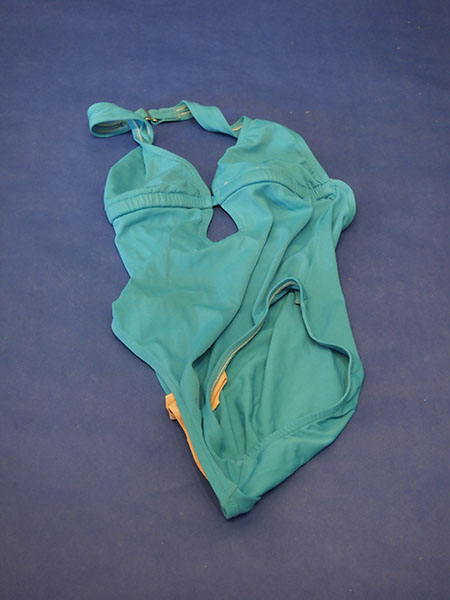![]() body | color | collections | commodity | cube | document | fabric | fetish | gender | glass | home | identity | living | machine | metal | minimal | mobility | narrative | olfactory | organic |
body | color | collections | commodity | cube | document | fabric | fetish | gender | glass | home | identity | living | machine | metal | minimal | mobility | narrative | olfactory | organic |
![]() pain | paper | plastic | plugs | power | protective | rectangular | ritual | round | sound | souvenir | spiritual | style | text-based | time | tool | touch | uniform | value | visual | warm | wood
pain | paper | plastic | plugs | power | protective | rectangular | ritual | round | sound | souvenir | spiritual | style | text-based | time | tool | touch | uniform | value | visual | warm | wood
| Athletics: Blue Bathing Suit | |||
Narrative: Blue Bathing Suit made of spandex and metal, sewn in the USA. Spandex fibers are produced in four different ways: melt extrusion, reaction spinning, solution dry spinning, and solution wet spinning. All of these methods include the initial step of reacting monomers to produce a prepolymer. Once the prepolymer is formed, it is reacted further in various ways and drawn out to make the fibers. The solution dry spinning method is used to produce over 94.5% of the world's spandex fibers. The first step is to produce the prepolymer. This is done by mixing a macroglycol with a diisocyanate monomer. The two compounds are mixed in a reaction vessel to produce a prepolymer. A typical ratio of glycol to diisocyanate is 1:2. The prepolymer is further reacted with an equal amount of diamine. This reaction is known as chain extension reaction. The resulting solution is diluted with a solvent to produce the spinning solution. The solvent helps make the solution thinner and more easily handled, and then it can be pumped into the fiber production cell. The spinning solution is pumped into a cylindrical spinning cell where it is cured and converted into fibers. In this cell, the polymer solution is forced through a spinneret. This causes the solution to be aligned in strands of liquid polymer. As the strands pass through the cell, they are heated in the presence of a nitrogen and solvent gas. This process causes the liquid polymer to react chemically and form solid strands. The resulting fibers are then treated with a finishing agent which can be magnesium stearate or another polymer. This treatment prevents the fibers' sticking together and aids in textile manufacture. The fibers are then transferred through a series of rollers onto a spool. Creora spandex has the highest market share and a strong reputation based on its functionality. Currently Creora has production facilities in Korea, China, Vietnam, Turkey, and Brazil. I purchased this bathing suit from a shop on 23rd street in 2011.
|
 |
||
![]()
